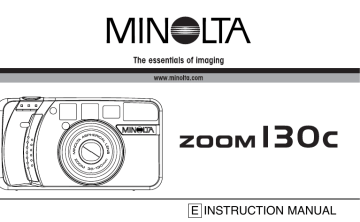
All the later model names included the word "Minolta", but the company name and brand name would differ until 1962. Many sources say that the Minolta name was crafted from " Mechanismus, Instrumente, Optik und Linsen von Tashima" ("Mechanism, Instruments, Optics and Lenses by Tashima") but it is more likely a backronym, inspired by (i) minoru ta (稔る田), "ripening rice-fields" (a strong image of health and fruitfulness in Japan, and in Japanese pronounced identically to "Minolta"), and (ii) "Molta" itself. A round MTS logo appeared at the same time, perhaps standing for " Molta Ta shima" or " Minolta Ta shima". The name Minolta was applied for and registered in 1933, and it was first used for a camera plainly called Minolta, inspired by the Plaubel Makina. Downloaded from the IPDL, in accordance to the IPDL policies.
KONICA MINOLTA CAMERA INSTRUCTION MANUAL REGISTRATION
Registration of the Minolta trademark (1933). The Asanuma company would distribute the Happy and Minolta cameras and assume all the advertising until 1945. Molta later entered an agreement with the Tokyo-based distributor Asanuma Shōkai, and the Sirius and Arcadia plate cameras were replaced by the Happy (whose brand name was owned by Asanuma). The cameras were still distributed by the company itself for a couple of years, and the Sirius and Arcadia were also distributed by Misuzu Shōkai as the Lomax and Eaton. The camera range was accordingly renamed: the Nifcarette became the Sirius Bebe, the Nifcaklapp became the Sirius and the Nifcasport became the Arcadia. The mention of Germany disappeared from the company name, and Heilemann and Neumann left the company respectively in November 1931 and in 1932, to found their own Neumann & Heilemann company, taking some employees with them. In 1931 the company was transformed into a stock corporation named Molta Gōshi-gaisha (モルタ合資会社), where Molta is an abbreviation of the German " Mechanismus Optik und Linsen von Tashima" ("Mechanism, Optics and Lenses by Tashima"). Heilemann dismissed all the strikers and opposed Tashima, who was favouring more moderate measures. In 1930, a strike occurred in the Mukogawa plant, whose director was Willy Heilemann.

At this early period, all the cameras were directly advertised and distributed by the company, which was using a round logo with the letters N, D, P H and C o assembled inside a circle, surely for Nichi Doku Photo Company. It was followed by the Nifcaklapp and Nifcasport folding cameras and by the Nifca-Dox strut-folder, all taking film plates or pack film. The first camera produced by the company was the Nifcarette released in 1929. A plant was built in Mukogawa (武庫川), in the prefecture of Hyōgo (兵庫県). Tashima got support from the German camera technicians Billy Neumann and Willy Heilemann, and the first cameras used lenses and shutters imported from Germany. The company was founded in Osaka on Novemby Kazuo Tashima, under the name Nichidoku Shashinki Shōten (日独写真機商店, meaning Japan-German Camera Store).

3.5 Rangefinder, fixed lens (Rapid film).3.3 Rangefinder, interchangeable lens (35mm).

1.9 Registered trademark "MINOLTA" sold.1.8 Konica Minolta: too little, too late.


 0 kommentar(er)
0 kommentar(er)
